When it was released here, the Honda CR-V’s first-generation RD1-RD3 versions might have confused many Honda guys. This is because it was unlike any Honda they have seen before. It’s raised so it has tall ground clearance, it’s more spacious than a Civic, and it looks like an SUV but handles like a car.
The Honda CR-V was introduced at the same time as its Toyota RAV4 rival back in 1997. Despite that though, it was probably your first encounter with a crossover. This is because unlike the smaller RAV4, the CR-V was larger so it had more usability.
So how did the Honda CR-V come about?
As you Honda fans might know by now, the CR-V was the Japanese car maker’s first-ever “sport utility vehicle.” For those who don’t know however, CR-V actually means “comfortable runabout vehicle.”

More like "Cool Rad Vehicle" right?
The Honda CR-V was of course dubbed as an SUV because there were few precedents for it, and the market didn’t exactly know what a crossover was at the time. Unlike a body-on-frame SUV, the CR-V used a unibody frame. This means that its top carriage and the chassis form a single structure. This enabled the CR-V to become cheaper than its contemporary SUV models. It handled better too because of the fact that unibody cars are typically lighter than body-on-frame vehicles.
While it handled more like a car, it had all the practicality and usability of an SUV. Its rear seats can be folded flat, and some variants even came with a picnic table. And as we’ve said, the CR-V also had a considerable ride height which allowed for light off-roading. Some variants even had all-wheel-drive.
Note though that the first-generation CR-V wasn’t that fast. It’s B-series inline-4 made 126 horsepower, but its double-wishbone suspension and short wheelbase made it very agile around corners.
For the second-generation 2002 RD4-RD9 CR-Vs, things became much more interesting. The CR-V came with the Honda K-Series engine (except for the diesel variant). That’s right, the CR-V shared the same engine as the 2001-2006 Civic Type R, Integra Type R, and Accord Euro Type R. All of these, however, were exclusive for the Japanese Domestic Market. This meant that the second-gen CR-V to this very day is a desirable engine donor for many performance builds. And alas, it also became one of the few ways for Pinoy Honda guys to get a taste of the Honda JDM power.
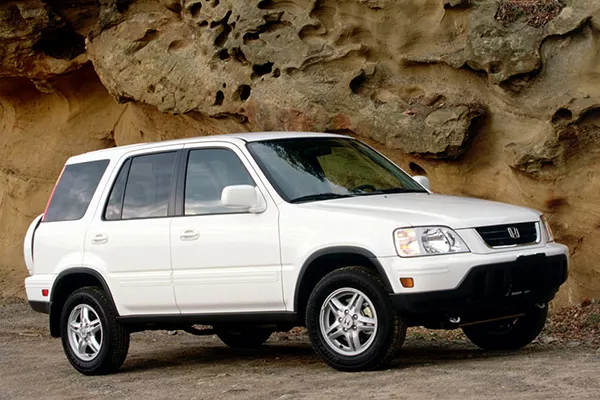
Pristine examples of the 2nd-gen CR-V can still fetch a hefty price in the used market.
The K-series engine found the Honda crossover however came with a different tune so a little tinkering is involved to bring out its full potential. Regardless, the Honda K-series has become one of the best inline-4 engines ever made. It is durable, it can fit into many models, and it’s easier than most inline-4 engines to tune for performance.
>>> Related: You may also be interested in this old compact car - Fiat 128 2016 for sale
Honda CR-V 2007-2011
Back to the CR-V, its third-generation model became more powerful, but it also became monstrously huge. At least in comparison to the old one. Sure, it was still smaller than most SUVs at that time, but longtime CR-V fans were intimidated by its size. Make no mistake though, this larger CR-V was, and still is a very practical car. It’s also the first CR-V to come with a lift-gate.

The 3rd-gen CR-V became larger and heftier.
As per its looks though, this was the time when the CR-V was slowly shedding the adventurous and youthful character that was found on older examples. It lost its rear-mounted spare tire, it came with larger 17-inch wheels, and it became more high-tech. And as we’ve said, the 3rd-gen is also far larger than its earlier examples. This meant that it required more effort to park, and was harder to squeeze in tight city roads. It was also heavier and that also meant less fuel efficiency and poorer handling.
And no, the third-generation CR-V was no longer using the beloved K-series Honda engine.
Honda CR-V 4th-gen and 5th-gen: The Family Chariot
Then came the fourth-generation CR-V in 2011, and the fifth-generation in 2017. Both are far more powerful and larger than the previous versions. They both offer more space, and their exterior designs are very aggressively modern. Just like the third-gen CR-V however, these two are unlike the rough and adventurous first- and second-generation CR-Vs.

The 4th-generation Honda CR-V.
For the Philippine market, the fifth-generation CR-V uses a continuously variable transmission, and most of its variants are full to the brim of safety features. There’s even a hybrid version in some markets. So while it has become more sophisticated and more comfortable, the CR-V is now used almost exclusively as a family chariot. There’s nothing wrong about that but for a car enthusiast, the fourth- and fifth-generation CR-V is more ideal as a daily driver.
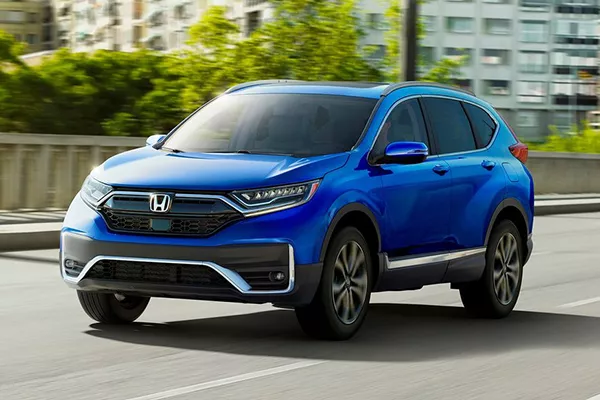
The latest iteration of the Honda CR-V.
Do you miss the old, first-generation Honda CR-V? Well, you can still get one today because there are a ton of surviving examples in decent shape. For the more pampered ones however, do prepare to pay for a premium. If you want an older Honda CR-V, do check out our car for sale section.
Do you miss the good old first-gen and 2nd-gen Honda CR-V?
For more nostalgic articles like this, keep reading here on Philkotse.com.
Know more about Honda CR-V 2026

The 2025 Honda CR-V is a midsize crossover SUV. For the Philippine market, it has three variants: the V Turbo CVT, VX Turbo CVT, and the RS e:HEV (hybrid) e-CVT.
The latest version of this Honda model has two different engine options. For the top-spec hybrid trim, it uses a 2.0-liter gasoline four-banger paired with a dual motor and lithium-ion battery. The combustion component alone produces up to 145 horsepower and 183 Nm of torque. The electric-powered component meanwhile, can churn out 181 horsepower and 335 Nm of torque.
Aboard the V and VX trims meanwhile is a 1.5-liter inline-4 engine that can churn out 187 horsepower and 240 Nm of torque.
Only the VX gets all-wheel-drive, while the rest are front-wheel-drive. All trims then use a continuously variable transmission (CVT), but the one on the hybrid trim is an electronic CVT (e-CVT).
In terms of dimensions, the all-new CR-V is 4,691mm long, 1,866mm wide, and 1,681mm (1,691mm for VX) in height. Both the hybrid and the V’s wheelbase then spans 2,701mm (2,700mm for VX).
Locally, the Honda CR-V competes against the likes of the Mazda CX-9, Cherry Tiggo 8 Pro, Kia Sorento, Hyundai Santa Fe, Peugeot 5008, etc.
>>> New and used Honda CR-V 2025 for sale in the Philippines
Honda CR-V Launch
The Honda CR-V was introduced to the Philippine market in September 2023. It launched with three different variants: the top-spec RS e:HEV CVT, the mid-spec VX CVT AWD, and the entry-level V CVT FWD. At launch, their prices ranged from Php 2.100 million to Php 2.590 million.
Honda CR-V Exterior
The 2025 CR-V carries the sleekness and the sportiness of the modern Honda design. Present on its front end are a pair of sharp LED headlamps which are outlined by LED daytime running lamps, a black-colored hexagonal mesh grille, and an angular front lower bumper.

The sides then feature power-folding side mirrors, a straight window line, and black plastic claddings for the VX and V. Its rear likewise gets a power tailgate, and a distinctively shaped pair of LED taillights.

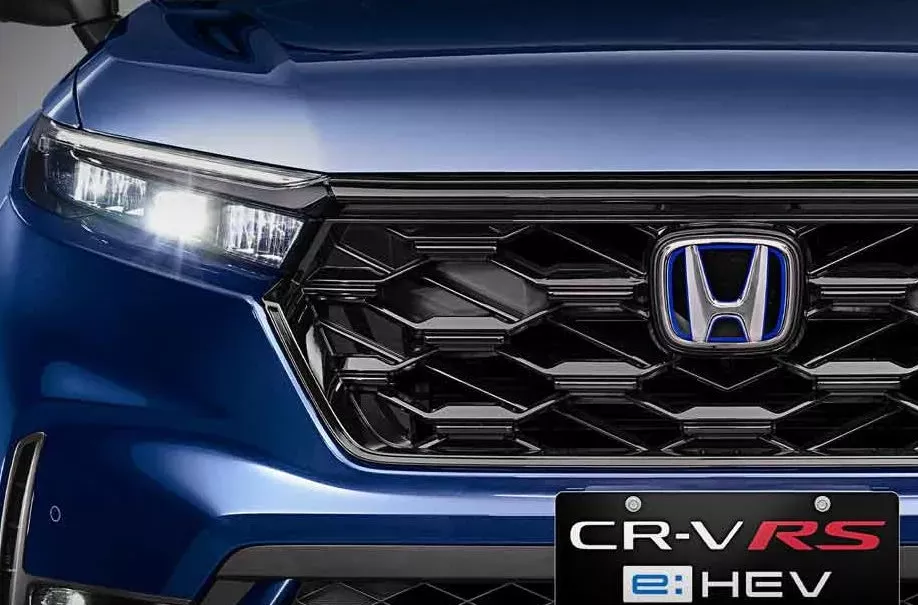
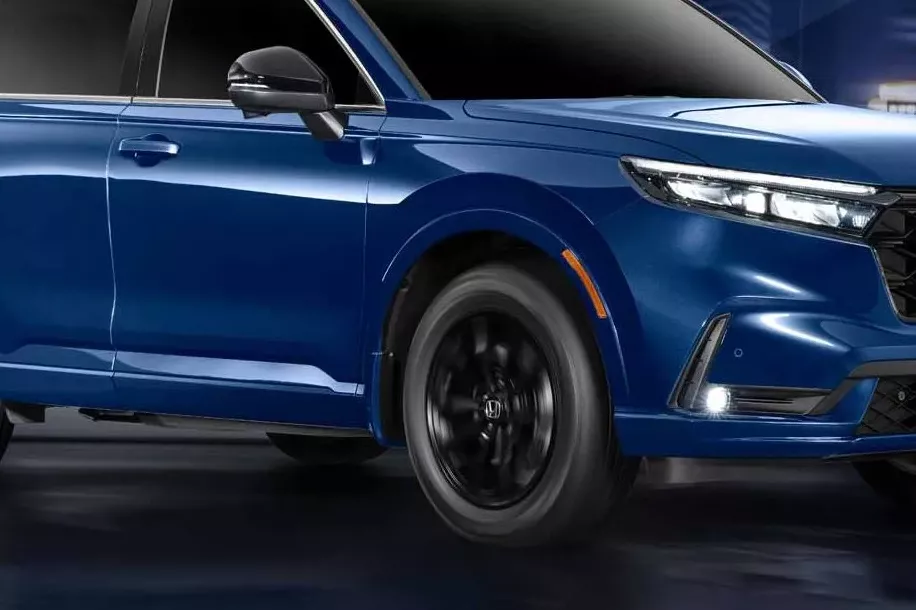
The RS hybrid trim stands out among the three as it gets plenty of additions mainly focused on style. This includes a black color for its side mirrors and antenna, body-color mudguards, and a set of 18-inch piano black alloy wheels.
Honda CR-V Interior
Inside, the top-spec RS e:HEV can seat up to five, whereas the V and VX can accommodate up to seven.
Present on all trims is a 10.2-inch digital gauge cluster, leather seats (w/ red stitching for the RS), a push-to-start button, USB A and C charging ports, an eight-way power adjustable driver’s seat (w/ power lumbar support for RS), auto-dimming rearview mirror, etc.
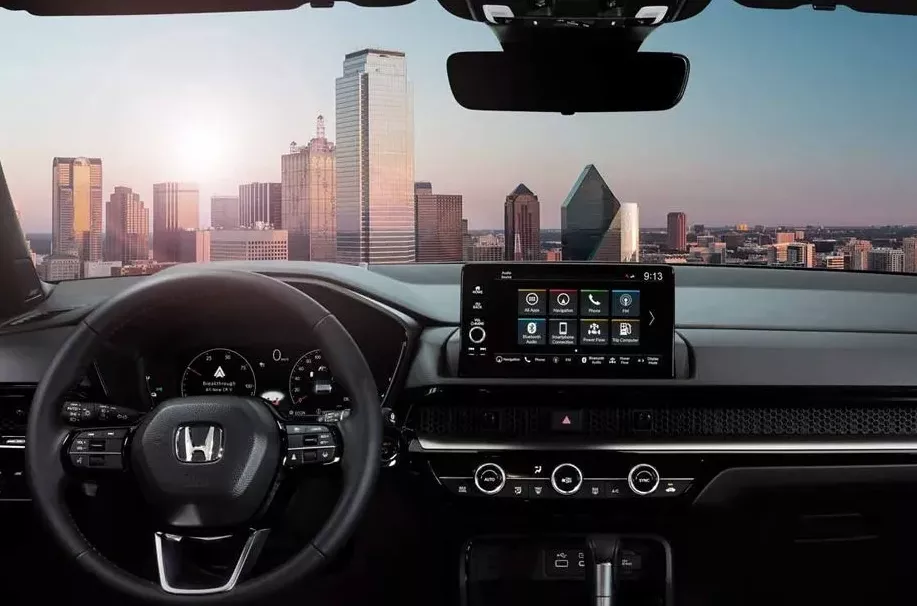

Only the RS and VX get rain-sensing wipers but exclusive only to the highest-spec trim are a sunroof, paddle shifters, and a drive mode selector with normal, eco, and sport. The rest do get an eco-drive mode.
For air-conditioning, the RS e:HEV gets a dual-zone automatic climate control system while the V and VX get a triple-zone automatic climate control system. All have physical buttons, as well.
Technology & Safety Features
Present on all CR-V trims is a 9-inch touchscreen with wireless Apple CarPlay and Android Auto. It also gets Bluetooth, USB connectivity, and audio streaming. Likewise available to all CR-V variants is a wireless charging pad.
Sound is fed to the CR-V’s cabin by a 12-piece Bose sound speaker (RS) or an eight-piece sound system (VX and V).
Present on all trims of the 2025 CR-V is the Honda Sensing driver-assistive suite. This includes features like adaptive cruise control with low-speed follow, collision mitigation braking, forward collision warning, lane keep assist, road departure mitigation, lane departure warning, automatic high beams, adaptive driving beams, lead car departure notification, and a driver attention monitor.
Those advanced safety features are then supported by seven airbags, anti-lock braking, stability control, hill-start assist, hill-descent control, a 360-degree view camera, tire pressure monitoring, ISOFIX child seat anchors, parking sensors (eight for RS, four for VX and V), a security alarm, an engine immobilizer, etc.
Platform & Chassis
The CR-V uses a MacPherson strut for the front and a multi-link suspension system for the rear. Braking is done via disc brakes for all four wheels and an electronic parking brake.
Engine & Drivetrain
There are two engine options for the 2025 CR-V. For the RS e:HEV, it gets a 2.0-liter gasoline engine paired with a dual-motor, lithium-ion battery setup. The gasoline mill alone produces up to 145 horsepower and 183 Nm of torque. The electric component then adds 181 horsepower and 335 Nm of torque to its output. Power is then sent to its front wheels via an e-CVT.
The VX and V, both utilize a 1.5-liter turbocharged gasoline engine that’s good for 187 horsepower and 240 Nm of torque. Both use CVT, but the V is front-wheel-drive, while the VX is all-wheel-drive.
There are five available color options for the 2025 CR-V. This includes Ignite Red Metallic, Meteoroid Gray Metallic, Lunar Silver Metallic, Platinium White Pearl, and Canyon River Blue Metallic.
The Honda CR-V is more than a competent challenger to other similarly sized crossovers when it comes to making power, and on-board features. It is also on top of the totem pole when it comes to providing a comprehensive safety kit. All the more to its credit is the fact that the latter comes as standard to all three of its trims.
Honda CR-V 2025 Price List
| Variants | Price |
|---|---|
| Honda CR-V V Turbo CVT | ₱2,100,000 |
| Honda CR-V V Turbo CVT (Platinum White Pearl) | ₱2,120,000 |
| Honda CR-V VX Turbo CVT | ₱2,290,000 |
| Honda CR-V VX Turbo CVT (Platinum White Pearl) | ₱2,310,000 |
| Honda CR-V RS e:HEV E-CVT | ₱2,605,000 |
| Honda CR-V RS e:HEV E-CVT (Platinum White Pearl) | ₱2,625,000 |
Honda CR-V Pros & Cons
Pros
- Stylish looks
- Comprehensive safety kit
- Generous output figures
- Plenty of onboard features
Cons
- Reduced cargo space on certain trims
Honda CR-V FAQs
1. What kind of car is the Honda CR-V 2025?
Sized and designed like a Volkswagen Tiguan, the 2025 Honda CR-V is a five-seat small crossover.
2. How many color options are there for the Honda CR-V to choose from?
The Honda CR-V is available in 4 colors including Ignite Red Metallic, Modern Steel Metallic, Platinum Pearl White, Cosmic Blue Metallic.
3. Is there a diesel Honda CR-V in the Philippines?
Honda Philippines offers the Honda CR-V in two variants – the five-seater gasoline and the seven-seater diesel.
4. Is the Honda CR-V 2025 Philippines a good car?
Yes, the CR-V is one of the country's most popular cars in the compact crossover segment. The Philippines saw the beginning of the Honda CR-V in the late 1990s and after two decades, it still remained one of the most prominent nameplates in its class.
5. How much is the Honda CR-V 2025 Philippines?
Honda CR-V 2025 price Philippines ranges from Php 2,100,000 to Php 2,610,000.
₱ 2,100,000 - ₱ 2,590,000
ExploreRecent posts
- Latest Honda CR-V Price Philippines 2026 Sep 23, 2025
- Honda Philippines price List 2026 Jan 18, 2023
- Thailand Spec Honda CR-V Oct 14, 2020
















